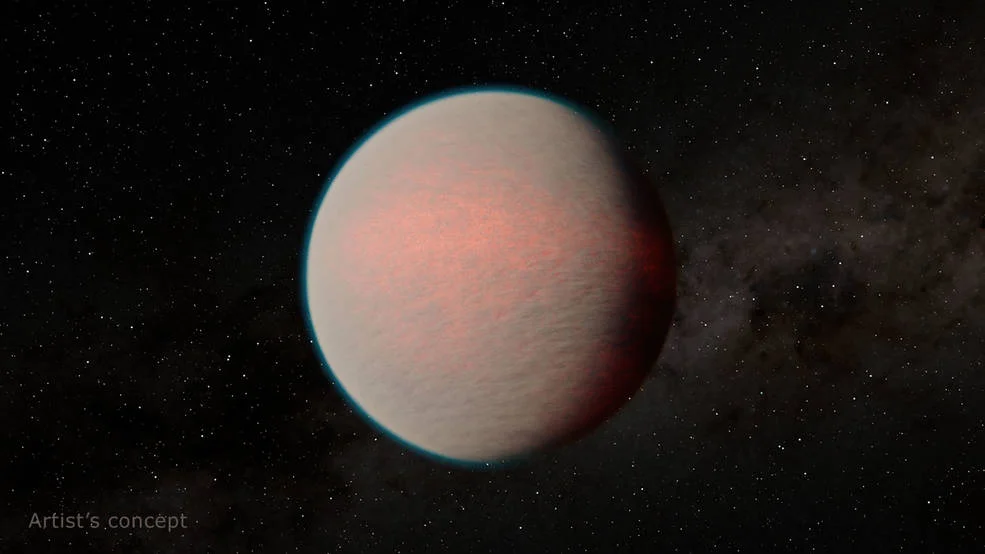Webb scrutinizes mysterious planet
- May 10, 2023
- 0
A scientific team is gaining new insights into the atmospheres of “mini-Neptunes,” a class of planets common in the galaxy but little known. NASA’s James Webb Space Telescope
A scientific team is gaining new insights into the atmospheres of “mini-Neptunes,” a class of planets common in the galaxy but little known. NASA’s James Webb Space Telescope

A scientific team is gaining new insights into the atmospheres of “mini-Neptunes,” a class of planets common in the galaxy but little known. NASA’s James Webb Space Telescope has observed a distant planet outside our solar system – and unlike anything inside – to discover what is a highly reflective world with a vaporous atmosphere. This is the closest look at a mysterious world, a “mini-Neptune”, almost inaccessible to previous observations.
And while the planet, called GJ 1214 b, is too hot to have oceans of liquid water, evaporated water may still make up most of its atmosphere.
“The planet is completely covered by some kind of haze or cloud layer,” said Elisa Kempton, a researcher at the University of Maryland and lead author of a new paper on the planet published in Nature. “Until this observation, the atmosphere remained completely hidden from us.” She noted that if the planet was truly water-rich, it could have been a “water world” with abundant watery and icy material at the time of its formation.
To overcome such a thick hurdle, the research team used a new approach: in addition to standard observations—capturing light from its parent star as it passed through the planet’s atmosphere—they tracked GJ 1214 b for nearly its entire orbit around it. star.
The observation demonstrates the power of the Webb Mid-Infrared Instrument (MIRI), which looks at wavelengths of light beyond the human-visible part of the electromagnetic spectrum. Using MIRI, the research team was able to create a kind of “heat map” of the planet as it orbited the star. The heatmap showed the day and night sides of the planet, detailing the composition of the atmosphere just before the planet’s orbit took it behind the star and when it emerged on the other side.
“Being able to get into a full orbit was crucial to understanding how the planet dissipates heat from day to night,” Kempton said. Said. “There is a great contrast between night and day. The night side is colder than the day side.” In fact, the temperature has changed from 535 to 326 degrees Fahrenheit (from 279 to 165 degrees Celsius).
Such a large shift is only possible in an atmosphere made up of heavier molecules such as water or methane that appear similar in MIRI observations. This means that GJ 1214 b’s atmosphere is not composed primarily of lighter hydrogen molecules, Kempton said, a potentially important clue to the planet’s history and formation — and perhaps even its watery origins.
It’s not a pristine atmosphere,” he said. “It doesn’t reflect the composition of the parent star around which it formed. Instead, it either lost too much hydrogen if it started with a hydrogen-rich atmosphere, or it formed from heavier elements—a more icy, water-rich material.”
colder than expected
Kempton noted that while the planet is warm by human standards, it is much colder than expected. This is because its extremely bright atmosphere, which baffles researchers, absorbs light from its parent star and reflects most of it, rather than heating it.
The new observations may open the door to a deeper understanding of the obscure planet type. Mini-Neptunes – or Sub-Neptunes as the paper calls them – are the most common type of planet in the galaxy, but they are mysterious to us because they are not found in our solar system. Measurements so far show that they largely resemble, for example, a scaled-down version of our own Neptune. Other than that, very little is known.
“For the last ten years, all we really knew about this planet was that the atmosphere was cloudy or hazy,” said Rob Zellem, an exoplanet researcher working with co-author and fellow exoplanet researcher Tiffany Kataria at NASA’s Jet Propulsion. laboratory . in Southern California. “This paper has very nice implications for more detailed interpretations of climate – for a detailed study of the physics going on in this planet’s atmosphere.”
The new study suggests that the planet may have formed farther away from its star, a type known as a red dwarf, and then gradually approached its current close orbit. A planet’s year – one revolution around a star – takes only 1.6 Earth days.
“If you find a planet very rich in water, the simplest explanation is that it formed further away from the host star,” Kempton said. Said.
Further observations will be required to determine the formation history of other mini-Neptune planets, as well as more details about GJ 1214 b. While a watery atmosphere seems likely for this planet, a significant methane component is also possible. And to draw broader conclusions about how mini-Neptunes form, they will need to be observed more deeply.
“Hopefully, by observing an entire population of objects like this, we can create a coherent story,” Kempton said.
Source: Port Altele
As an experienced journalist and author, Mary has been reporting on the latest news and trends for over 5 years. With a passion for uncovering the stories behind the headlines, Mary has earned a reputation as a trusted voice in the world of journalism. Her writing style is insightful, engaging and thought-provoking, as she takes a deep dive into the most pressing issues of our time.